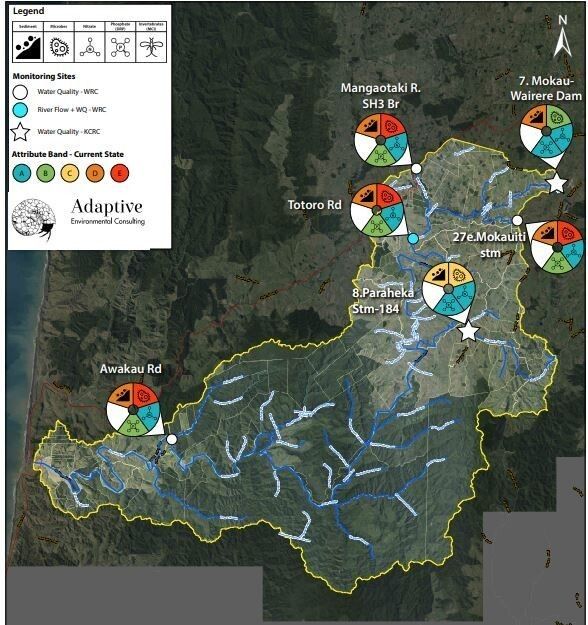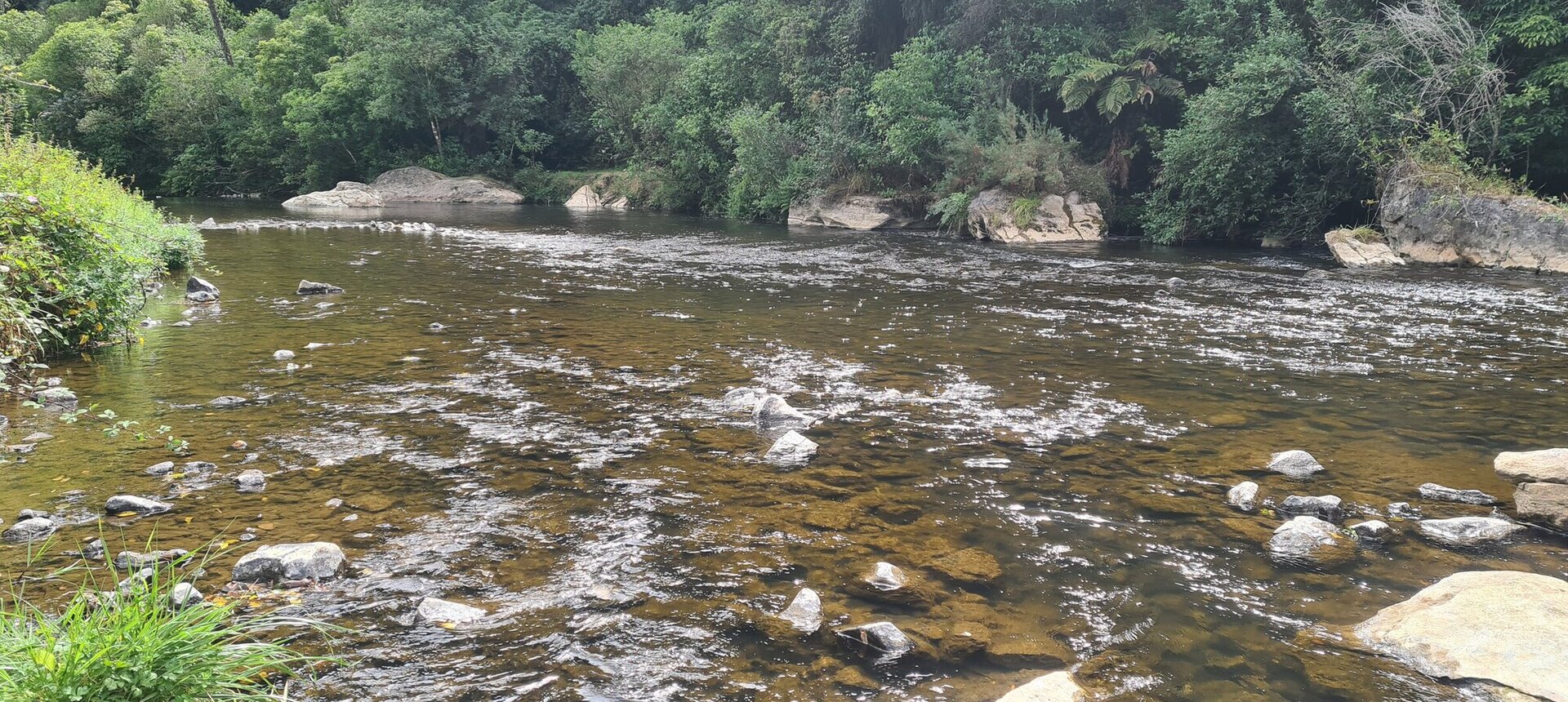2024 Quarterly Results
August 2024
Water quality was Fair. Dissolved inorganic nitrogen was slightly elevated and water clarity was low.
E. coli was very low (130) and well within recommended health levels for swimming (540). Nitrate concentrations were well below ecological toxicity impacts (2.4 mg/L). Ammonia concentrations were low, falling well below ecological toxicity impacts (0.24 mg/L) Dissolved inorganic nitrogen (DIN) was slightly elevated (0.67 mg/L), potentially impacting ecological health. DIN concentrations greater than 0.5 mg/L can cause ecological impacts like excessive growth of algae and aquatic plants, and loss of sensitive species. Dissolved reactive phosphorus was exceptionally low (0.005 mg/L). Water clarity was poor (1.15 m), relative to the national bottom line (1.34 m).
Sample Collection Day: 13th August 2024

Mokau River – Summary of water quality collected at 15 sites across the Mokau River catchment on 13th August 2024
E. coli, ammonia and dissolved reactive phosphorus were low at most sites. The key contaminants were suspended sediment and nitrate.
E. coli: 73% of all sites had low concentrations (≤210), while 27% (4 sites) had slightly elevated concentrations (between 310 to 410). Nitrate and Ammonia: 100% of sites were well below toxicity levels. Nitrate range (0.2 – 0.92 mg/L); Ammonia range (<0.005 - 0.03). Dissolved inorganic nitrogen (DIN): 53% of sites had low concentrations (≤0.47 mg/L) and 47% fell above the ecological impact threshold of 0.5 mg/L. The highest DIN concentration was 0.93 mg/L. Dissolved reactive phosphorus: 93% of sites had low concentrations (between <0.002 to 0.009 mg/L), 7% (1 site) had slightly elevated concentrations 0.012 mg/L. Water clarity: 27% (4 sites) had good water clarity (A or B band), 7% (1 site) had reduced water clarity (C band) and the remaining 67% had poor water clarity (D band). Bands for each site relate to the national bottom line (NBL) for water clarity and are dependent on landscape characteristics including geology, climate and elevation. The NBL for Mokau River’s monitoring sites are either 1.34 m or 0.61 m, dependant on the local landscape characteristics.
May 2024
Overall, water quality was Good above the Wairere Dam on Mokau River, only water clarity was slightly slow.
E. coli was very low (110) and well within recommended health levels for swimming (540). Nitrate concentrations were well below ecological toxicity impacts (2.4 mg/L). Ammonia concentrations were exceptionally low, falling well below ecological toxicity impacts (0.24 mg/L) Dissolved inorganic nitrogen was low (0.43 mg/L). Dissolved reactive phosphorus was exceptionally low (0.004 mg/L). Water clarity was fair (1.52 m), relative to the national bottom line (1.34 m).
Collection date: 14th May 2024

Mokau River – Summary of water quality collected at 15 sites across the Mokau River catchment May 2024
E. coli and Nutrients (nitrate, ammonia and dissolved reactive phosphorus) were low at most sites. The key contaminant was suspended sediment.
E. coli: 93% of all sites had low concentrations (≤240) and 7% (1 site) had elevated concentrations (510). Nitrate and Ammonia: 100% of sites were well below toxicity levels. Nitrate range (0.15 – 0.79 mg/L); Ammonia range (<0.005 - 0.02). Dissolved inorganic nitrogen: 73% of sites had low concentrations (≤0.44 mg/L) and 27% (4 sites) fell above the ecological impact threshold of 0.5 mg/L with the highest concentration being 0.79 mg/L. Dissolved reactive phosphorus: 100% of sites had low concentrations (between <0.002 - 0.008 mg/L). Water clarity: 60% of sites had good water clarity (A or B band), 20% (3 sites) had reduced water clarity (C band) and the remaining 20% had poor water clarity (D band). Bands for each site relate to the national bottom line (NBL) for water clarity and are dependent on landscape characteristics including geology, climate and elevation. The NBL for Mokau River’s monitoring sites are either 1.34 m or 0.61 m, dependant the local landscape characteristics.
February 2024
Overall, water quality was Fair above the Wairere Dam on Mokau River.
E. coli was slightly elevated (320) but fell within recommended health limits for swimming (540). Nitrate concentrations were well below ecological toxicity impacts (2.4 mg/L). Ammonia concentrations were also low, falling below ecological toxicity impacts (0.24 mg/L) Dissolved inorganic nitrogen was low (0.39 mg/L). Dissolved reactive phosphorus was exceptionally low (0.006 mg/L). Water clarity was poor (1.03 m) relative to the national bottom line (1.34 m).
Collection date: 28th February 2024

Mokau River – Summary of water quality collected at 15 sites across the Mokau River catchment February 2024
Nutrient concentrations (nitrate, ammonia and dissolved reactive phosphorus) were low at most sites. Key contaminants were E. coli and suspended sediment.
E. coli: 60% of all sites had low concentrations (≤260) and 40% had slightly elevated concentrations (between 300 - 450). Nitrate and Ammonia: 100% of sites were well below toxicity levels. Nitrate range (0.04 – 0.53 mg/L); Ammonia range (<0.005 - 0.03). Dissolved inorganic nitrogen: 87% of sites had low concentrations (≤0.4 mg/L) and 13% (2 sites) fell above the ecological impact threshold of 0.5 mg/L with the highest concentration being 0.54 mg/L. Dissolved reactive phosphorus: 100% of sites had low concentrations (between <0.002 - 0.01 mg/L). Water clarity: 53% of sites had good water clarity (A or B band), 13% (2 sites) had reduced water clarity (C band) and 33% of sites had poor water clarity (D band). Bands for each site relate to the national bottom line (NBL) for water clarity and are dependent on landscape characteristics including geology, climate and elevation. The NBL for Mokau River’s monitoring sites are either 1.34 m or 0.61 m, dependant the local landscape characteristics.
Water Quality
Summary 2023

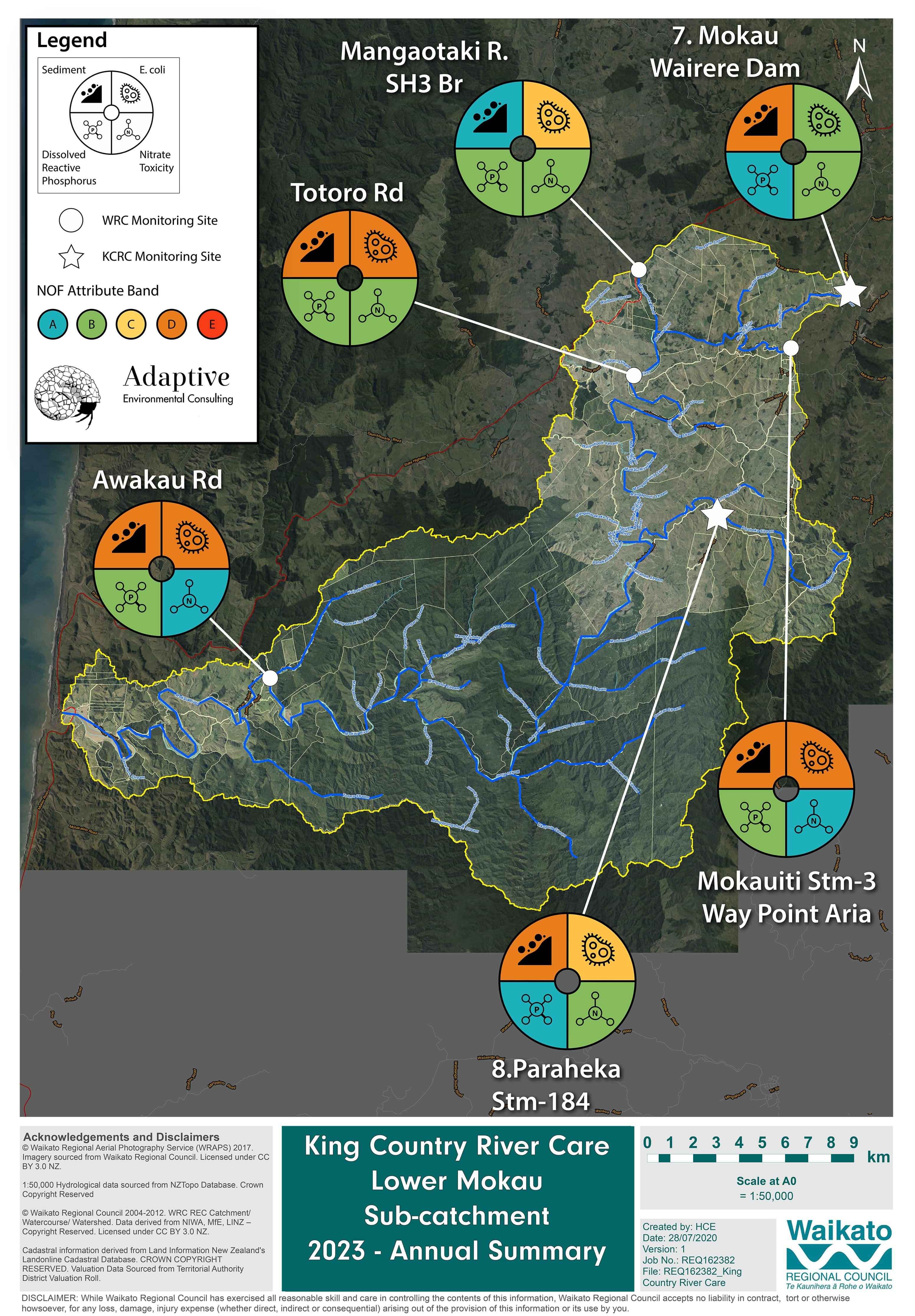
Water samples were collected from 6 stream and river sites across the Lower Mokau. Monitoring sites were located on Paraheka stream, Mokauiti stream, Mangaotaki River and the Mokau River. The below water quality dial summarises the results from 45 individual samples collected across 6 sites, between January 2023 and December 2023.
Water clarity was poor, indicated elevated levels of suspended sediment, which impacts aquatic life. E. coli was slightly elevated which can pose a slight risk to human health when swimming. Nitrogen and dissolved reactive phosphorus (DRP) were low, which supports river health. Water clarity did not meet national water quality standards, while all other attributes did meet national standards.
Arrows indicate an increase or decrease in values compared to the baseline. The baseline was calculated from 5 years of data collected by Waikato Regional Council at 5 sites, between 2015 and 2019. An increase in water clarity is positive for river health, while an increase in all other attributes may impair river health.
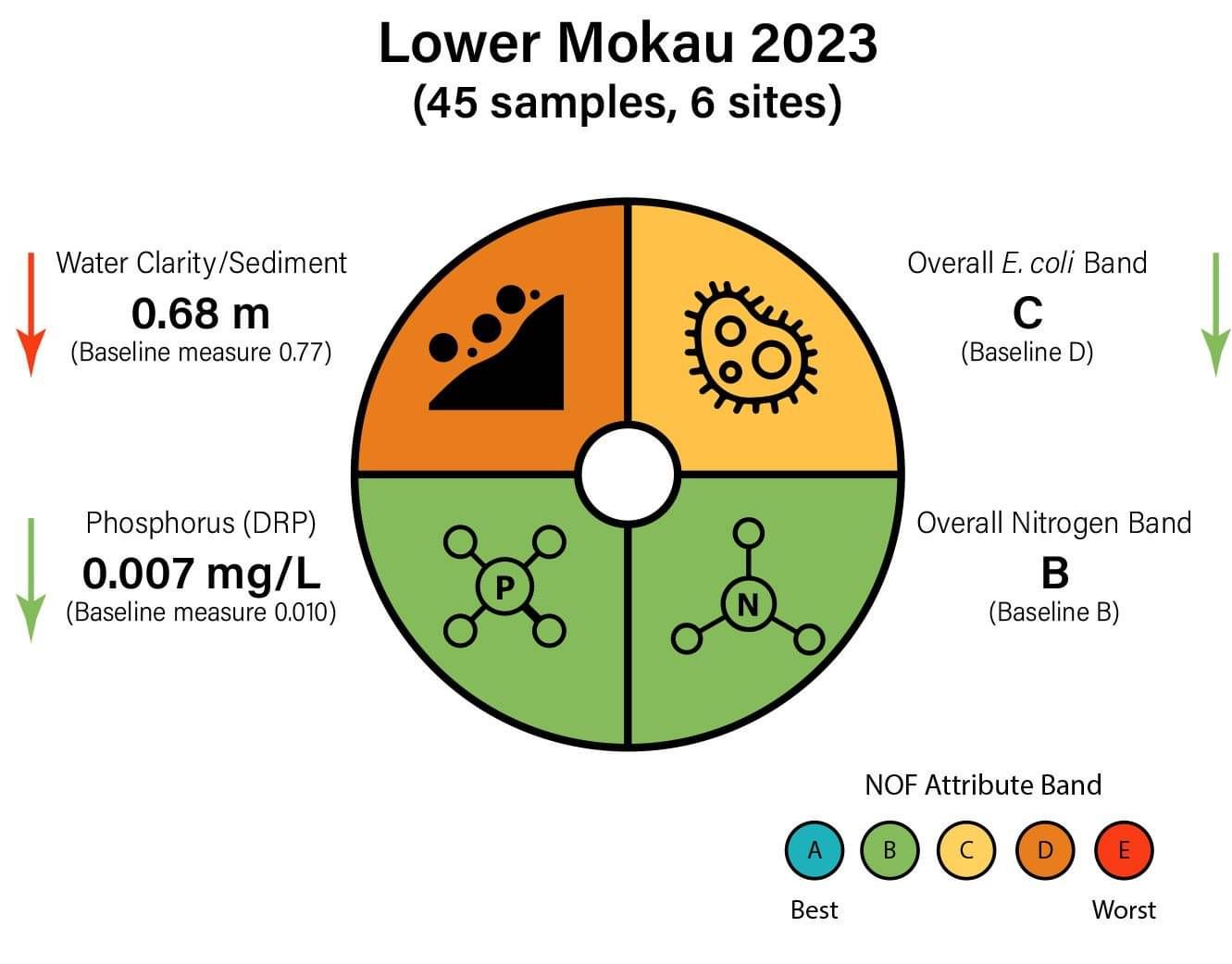
Aquatic Biodiversity Summary
Biodiversity monitoring includes eDNA, collected by KCRC, and traditional biodiversity monitoring techniques (netting of freshwater invertebrates and netting and electrofishing of freshwater fish), by Waikato Regional Council (WRC). eDNA sampling has been done by KCRC, in autumn and winter in 2021, 2022 and 2023. WRC monitors most sites every 1 to 2 years, between November and March. If more than one results is available for any single monitoring location the results for that site are averaged across years.
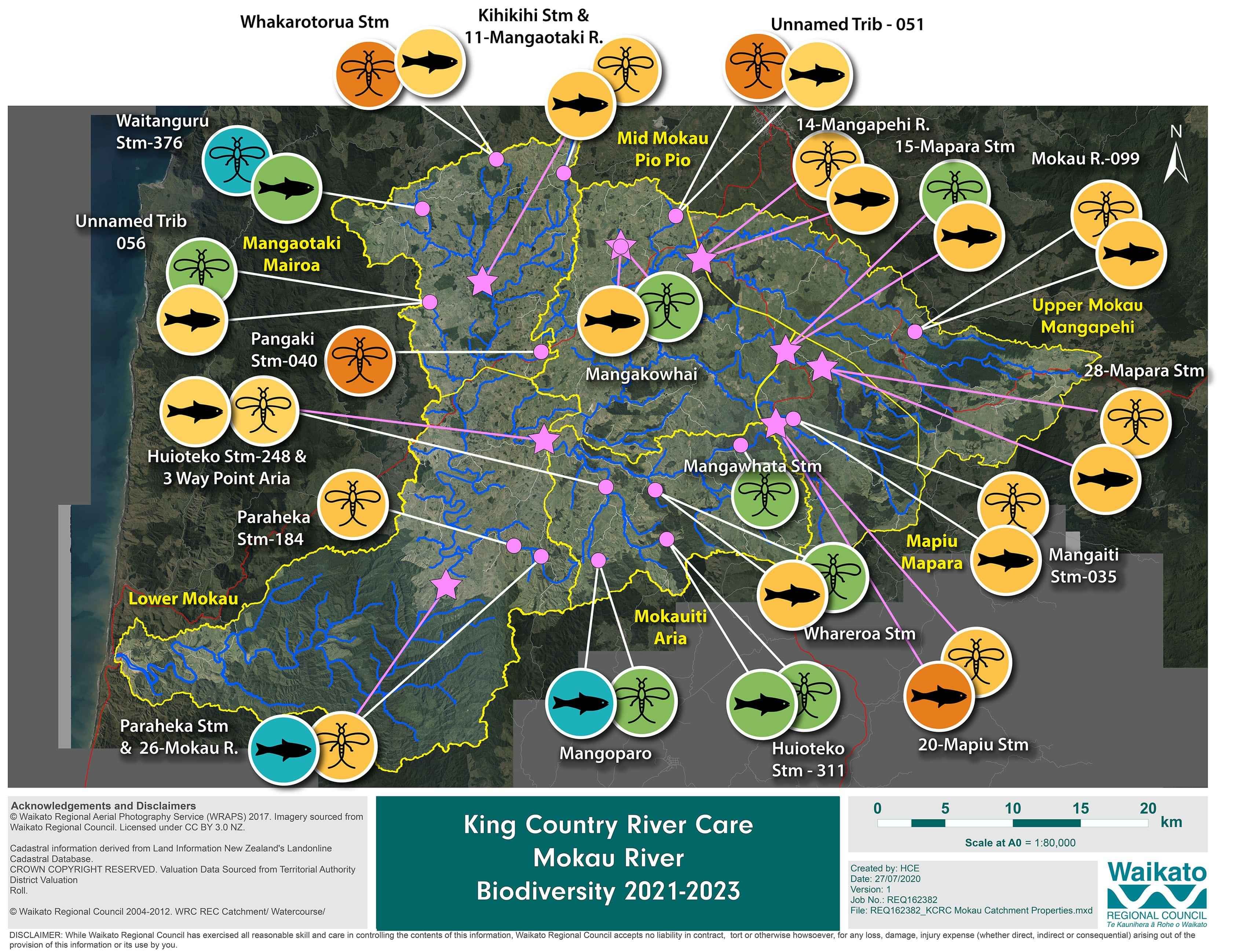
Mōkau River has signs of ecological stress.
Freshwater invertebrate MCI scores indicate ecological stress at some sites in all sub-catchments expect for Mokauiti-Aria, where nearly all sites had good MCI scores and two out of three sites had good fish scores. Mangaotaki-Mairoa also had two sites with good invertebrate scores.
The number of insect species detected from eDNA (an indicator for ecological health) were low to moderate, ranging between 20 to 40 species across the 7 sub-catchments. Mapiu stream, Mapara stream, Mangaotaki and Mokauiti streams had the highest number of insect species, while Mangaokowhai stream and the Upper Mōkau had the lowest number of insect species detected.
Native freshwater mussels, a rare invertebrate species and filter feeder, were detected in the sub-catchments of upper Mōkau, Mokauiti-Aria and the lower Mōkau.
The Mōkau river has a diverse fish community in the lower reaches (14 species), however, fish diversity is very low in the mid and upper reaches, consisting mainly of eels (longfin and shortfin) and brown trout.
Only one whitebait species was detected, Īnanga, in the lower reaches only.
Threatened fish species detected in the catchment include, lamprey, Īnanga, redfin bully, longfin eel and torrentfish.
Four species of introduced fish detected, mosquito fish, goldfish, brown trout and rainbow trout.
Barriers to fish migration in the Mōkau river, including manmade structures like dams and perched culverts and natural features like high waterfalls, will be restricting fish diversity.
The Mōkau River has at least two large manmade barriers to fish migration, the Mokauiti Dam and the Wairere Dam, and at least on large natural barrier, Omaru falls (45m high).
Many of our native species are excellent climbers, elvers can scale waterfalls up to 40 m high and kōaro even higher than this.
Mokau Sub Catchment Areas
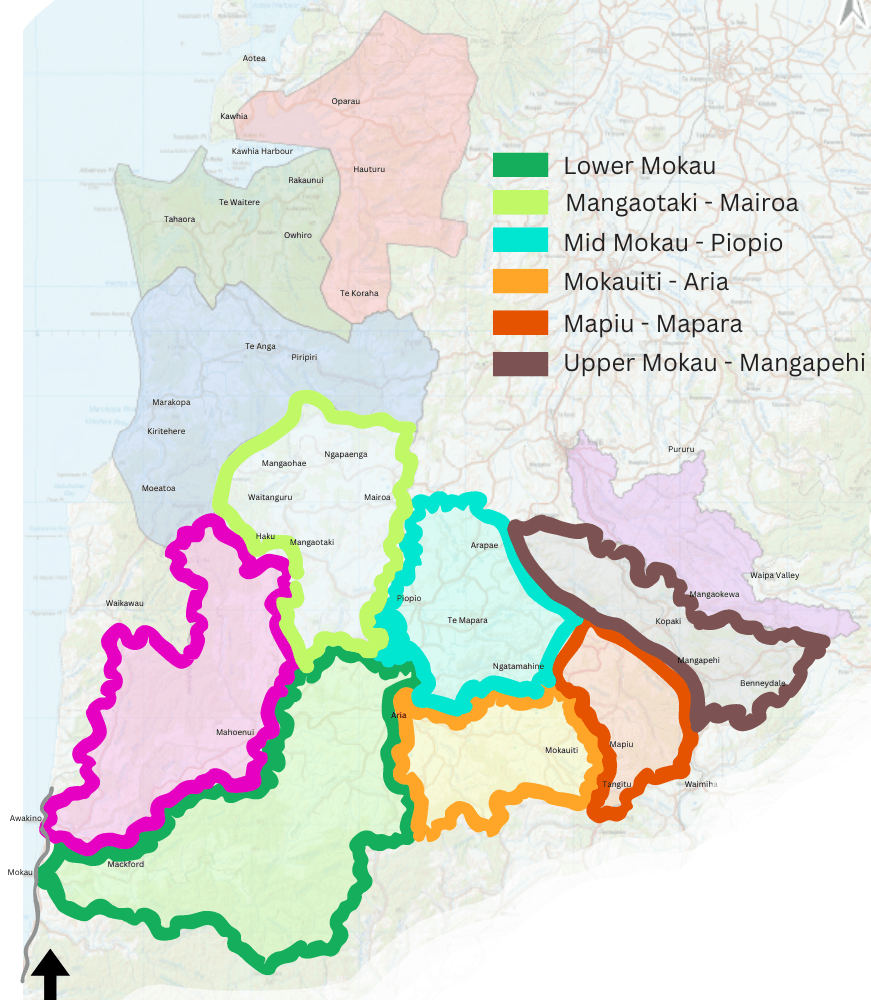
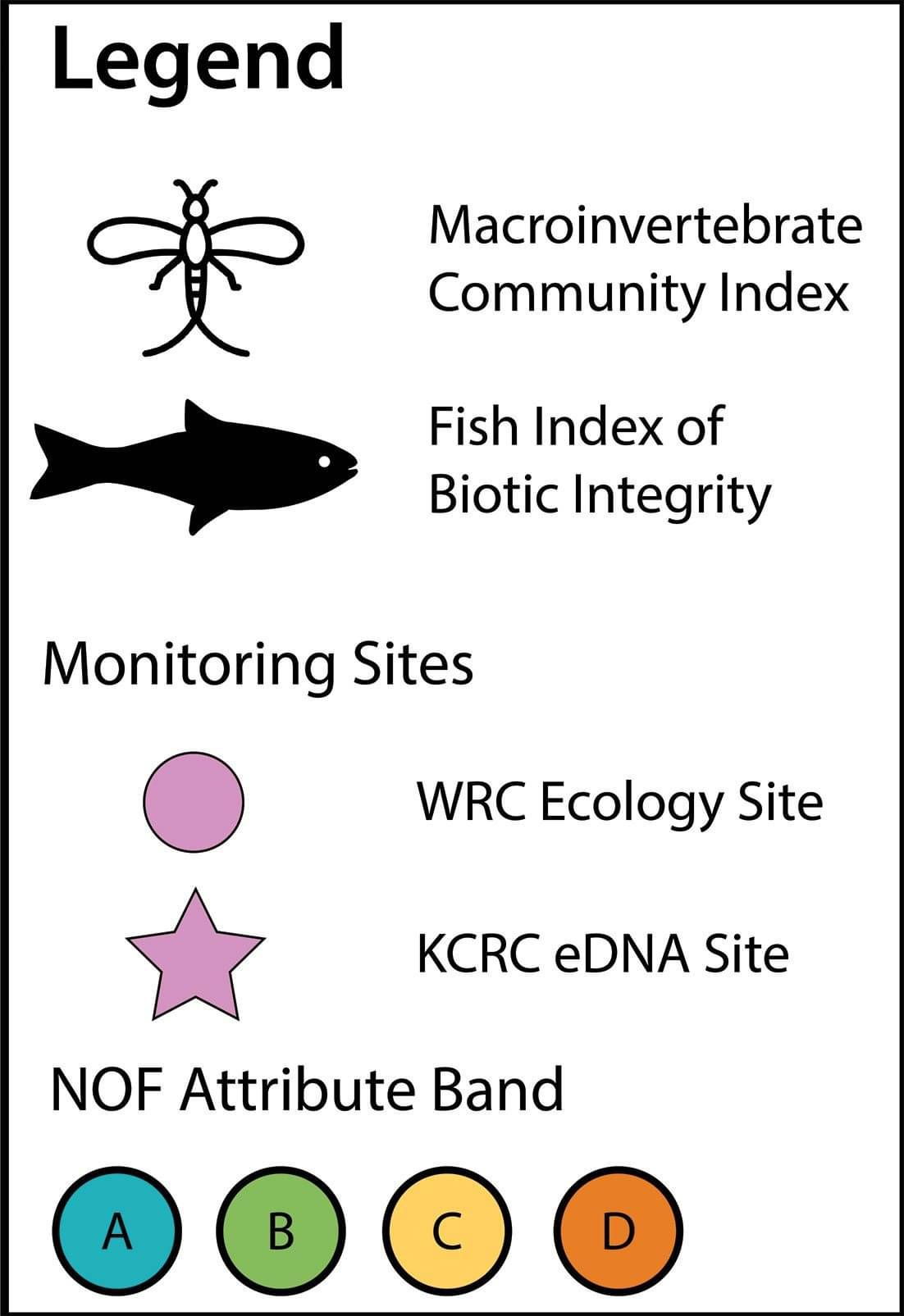
2023 Quarterly Results
November 2023
Overall, water quality at Mokau River, above the Wairere Dam was good on 13th November 2023.
E. coli was low (190). Nitrate and Ammonia concentrations were well below toxicity levels (Nitrate 0.37 mg/L; Ammonia 0.02 mg/L). Dissolved inorganic nitrogen was low (0.39 mg/L). Dissolved reactive phosphorus was exceptionally low (0.006 mg/L). Water clarity was poor (1.03 m) relative to the national bottom line (1.34 m).
Collection date: 13 November 2023

Mokau River – All sites in sub-catchment (November 2023)
Nutrient concentrations (nitrate, ammonia and dissolved reactive phosphorus) were low at most sites. Key contaminants were E. coli and water clarity.
E. coli: 56% of all sites had low concentrations (≤230), 25% had slightly elevated concentrations (between 280 - 530) and 19% had elevated concentrations (> 730). Nitrate and Ammonia: concentrations at 100% of sites were below toxicity levels (Nitrate ≤ 0.62 mg/L; Ammonia ≤ 0.02). Only one site had Dissolved Inorganic Nitrogen (DIN) concentrations above 0.5 mg/L. Ecological impacts, including problematic growth of algae and/or aquatic plants and loss of sensitive aquatic species are likely to occur when DIN regularly exceeds 0.5 mg/L. Dissolved reactive phosphorus: 94% of sites had low concentrations (≤ 0.009 mg/L) and one site (16%) had slightly elevated concentrations (0.011 mg/L).Water clarity: 44% of sites had good water clarity (A or B band), two sites (13%) had reduced water clarity (C band) and 44% of sites had poor water clarity (D band). Bands for each site relate to the national bottom line (NBL) for water clarity and are dependent on landscape characteristics including geology, climate and elevation. The NBL for Mokau River’s monitoring sites are either 1.34 m or 0.61 m, dependant the local landscape characteristics.
September 2023
Overall, water quality at Mokau River, above the Wairere Dam was fairly good on 13th September. E. coli and dissolved reactive phosphorus were low, while the concentration of suspended sediment was elevated and Dissolved Inorganic Nitrogen was slightly elevated. E. coli was low (160). Nitrate and ammonia concentrations were well below toxicity levels (Nitrate 0.59 mg/L; Ammonia 0.02 mg/L). Dissolved inorganic nitrogen was 0.61 mg/L, potentially impacting the health of the river. Dissolved reactive phosphorus concentrations was exceptionally low (0.005 mg/L). Water clarity was poor (0.83 m), relative to the national bottom line (1.34 m).
Collection date: 13 September 2023

Mokau River – All sites in all sub-catchments (September 2023)
Summary of water quality collected at 16 sites located across the Mokau River catchment sampled on 12th or 13th of September. E. coli: 63% of all sites had low concentrations (≤220), 25% had slightly elevated concentrations (between 270 - 380) and 13% of sites had elevated concentrations (> 550). Nitrate and Ammonia: 100% of sites had concentrations below toxicity levels (Nitrate ≤ 0.79 mg/L; Ammonia ≤ 0.09). However, 50% of sites had Dissolved Inorganic Nitrogen (DIN) concentrations over 0.5 mg/L. Ecological impacts, including problematic growth of algae and/or aquatic plants and loss of sensitive aquatic species are likely when the combined concentration of DIN regularly exceed 0.5 mg/L. Dissolved reactive phosphorus: 94% of sites had low concentrations (≤ 0.009 mg/L) and one site (16%) had an elevated concentration (0.011 mg/L). Water clarity: 56% of sites had good water clarity (A or B band) and 44% of sites had poor clarity (D band). Bands for each site relate to the national bottom line for water clarity, which is either 1.34 m or 0.61 m, and is dependent on the local geology, climate and elevation.
May 2023
E. coli concentrations were elevated at both sites (≥ 310). Nitrate and ammonia concentrations were the same for both sites and were below toxicity levels (Nitrate 0.84 mg/L; Ammonia 0.01 mg/L). Both sites had a dissolved inorganic nitrogen concentration exceeding 0.5 mg/L, potentially impacting the health of the river. Dissolved reactive phosphorus concentrations were exceptionally low at both sites (0.006 mg/L). Water clarity was poor at both sites (≤ 0.25 m), relative to the national bottom line (NBL). The NBL is 1.34 m at 7-Mokau River above Wairere Dam; 0.61 m at 8-Paraheka Stream.
Sample date 14 May 2023.
Mokau River – All sites in all sub-catchments (May 2023)
This summarises the results collected across the Mokau River catchment from 27 sites sampled on either the 8th or 14th of May: E. coli: 58% of all sites had low concentrations (≤260) and 42% had slightly elevated concentrations (between 270 - 360). Nitrate and Ammonia: 100% of sites had concentrations below toxicity levels (Nitrate ≤ 2.39 mg/L; Ammonia ≤ 0.04). However, 67% of sites had Dissolved Inorganic Nitrogen (DIN) concentrations over 0.5 mg/L. Ecological impacts, including problematic growth of algae and/or aquatic plants and loss of sensitive aquatic species are likely when the combined concentration of DIN regularly exceed 0.5 mg/L. Dissolved reactive phosphorus: 83% of sites had low concentrations (≤ 0.009 mg/L) and 17% of sites had elevated concentrations (0.011 – 0.017 mg/L). Water clarity: 8% of sites had good water clarity (A or B band), 8% had moderate clarity (C band) and 83% of sites had poor clarity (D band). Bands for each site relate to the national bottom line for water clarity, which is either 1.34 m or 0.61 m, and is dependent on the local geology, climate and elevation.
February 2023
Summary 2022
The water quality dial for Lower Mokau combines data collected at 6 monitoring sites between January – December 2022, representing 54 individual samples. Nitrates and dissolved reactive phosphorus (DRP) were low. E. coli was elevated, while water clarity was low indicating elevated sediment loading. Arrows indicate an increase or decrease in values compared to the sub-catchment baseline (2015 – 2020). An increase in water clarity is positive for river health while an increase in all other attributes may impair river health.

2021 Summary
E. coli and Sediment are the main contaminants of concern in the Lower Mokau.
Site 7-Mokau River above the Wairere dam had the best water quality and the Waikato Regional Council sites had the lowest water quality in 2021.
Attribute bands
A (or blue is the best) through to E (red) which is the worst.
